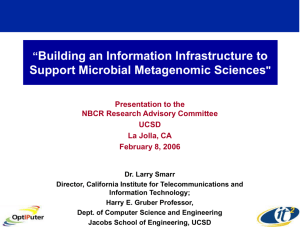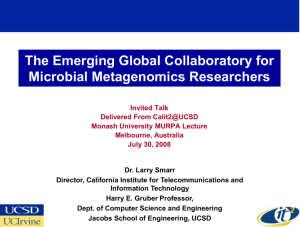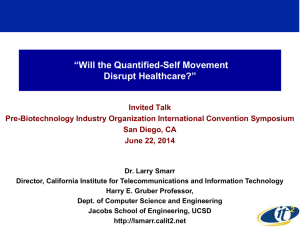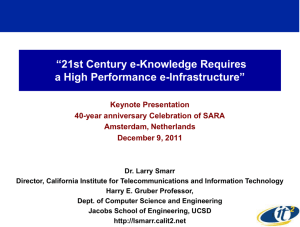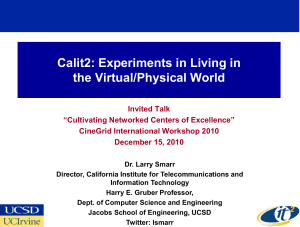PPT - Larry Smarr - California Institute for Telecommunications and
advertisement
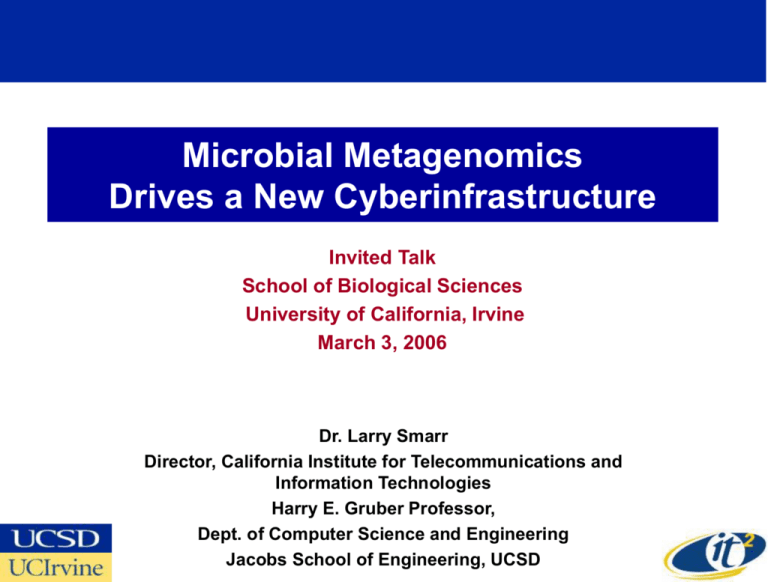
Microbial Metagenomics Drives a New Cyberinfrastructure Invited Talk School of Biological Sciences University of California, Irvine March 3, 2006 Dr. Larry Smarr Director, California Institute for Telecommunications and Information Technologies Harry E. Gruber Professor, Dept. of Computer Science and Engineering Jacobs School of Engineering, UCSD Abstract Calit2, in partnership with J. Craig Venter Institute in Rockville, MD, and UCSD's Center for Earth Observations and Applications at Scripps Institution of Oceanography, will build a state-of-the-art computational resource and develop software tools to decipher the genetic code of communities of microbial life in the world's oceans. The Gordon and Betty Moore Foundation has awarded $24.5 million over seven years to create the Community Cyberinfrastructure for Advanced Marine Microbial Ecology Research and Analysis (CAMERA). Scientists will use CAMERA for metagenomics research -analyzing microbial genomic sequence data in the context of other microbial species, as well as in comparison to a variety of other "metadata" such as the chemical and physical conditions in which microbes are sampled. The CAMERA project will contain the results of the Venter Institute's Sorcerer II Expedition, which carried out the first large-scale genomic survey of microbial life in the world's oceans to produce the largest gene catalogue ever assembled. Sorcerer II is expected to more than double the number of protein sequences currently available in the National Institutes of Health's GenBank. In addition to Sorcerer II's ecological genomic data, the CAMERA database will be augmented by the full genomes of more than 150 critical marine microbes enabling new comparative genomics studies. Calit2 Brings Computer Scientists and Engineers Together with Biomedical Researchers • Some Areas of Concentration: – – – – – – – – – Metagenomics Genomic Analysis of Organisms Evolution of Genomes Cancer Genomics Human Genomic Variation and Disease Mitochondrial Evolution Proteomics Computational Biology Information Theory and Biological Systems UC Irvine UC San Diego 1200 Researchers in Two Buildings Evolution is the Principle of Biological Systems: Most of Evolutionary Time Was in the Microbial World You Are Here Much of Genome Work Has Occurred in Animals Source: Carl Woese, et al Calit2 Researcher Eskin Collaborates with Perlegen Sciences on Map of Human Genetic Variation Across Populations “We have characterized whole-genome patterns of common human DNA variation by genotyping 1,586,383 single-nucleotide polymorphisms (SNPs) in 71 Americans of European, African, and Asian ancestry.” David A. Hinds, Laura L. Stuve, Geoffrey B. Nilsen, Eran Halperin, Eleazar Eskin, Dennis G. Ballinger, Kelly A. Frazer, David R. Cox. “Whole-Genome Patterns of Common DNA Variation in Three Human Populations” Science 18 February, 2005: 307(5712):1072-1079. “More detailed haplotype analysis results are available at http://research.calit2.net/hap/wgha/ “ “Although knowledge of a single genetic risk factor can seldom be used to predict the treatment outcome of a common disease, knowledge of a large fraction of all the major genetic risk factors contributing to a treatment response or common disease could have immediate utility, allowing existing treatment options to be matched to individual patients without requiring additional knowledge of the mechanisms by which the genetic differences lead to different outcomes .” For Mitochondrial Diseases It Has Been More Productive to Classify Patients by Genetic Defect Rather than by Clinical Manifestation Over the past 10 years, mitochondrial defects have been implicated in a wide variety of degenerative diseases, aging, and cancer… The same mtDNA mutation can produce quite different phenotypes, and different mutations can produce similar phenotypes. …The essential role of mitochondrial oxidative phosphorylation in cellular energy production, the generation of reactive oxygen species, and the initiation of apoptosis has suggested a number of novel mechanisms for mitochondrial pathology. --Douglas Wallace, Science, Vol. 283, 1482-1488, 5 March 1999 Comparative Genomics Can Reveal Biological Facts That Are Not Visible Within a Species Co-Authors Pavel Pevzner and Glenn Tesler, UCSD December 9, 2004 April 1, 2004 December 05, 2002 “After sequencing these three genomes, it is clear that substantial rearrangements in the human genome happen only once in a million years, while the rate of rearrangements in the rat and mouse is much faster.” --Glenn Tesler, UCSD Dept. of Mathematics Advanced Algorithmic Techniques Reveal Unexpected Results “Many of the chicken– human aligned, non-coding sequences occur far from genes, frequently in clusters that seem to be under selection for functions that are not yet understood.” Nature 432, 695 - 716 (09 December 2004) Microbial Metagenomics is a Rapidly Emerging Field of Research “Despite their ubiquity, relatively little is known about the majority of environmental microorganisms, largely because of their resistance to culture under standard laboratory conditions.” “The application of high-throughput shotgun sequencing environmental samples has recently provided global views of those communities not obtainable from 16S rRNA or BAC clone– sequencing surveys .” Comparative Metagenomics of Microbial Communities Susannah Green Tringe, Christian von Mering, Arthur Kobayashi, Asaf A. Salamov, Kevin Chen, Hwai W. Chang, Mircea Podar, Jay M. Short, Eric J. Mathur, John C. Detter, Peer Bork, Philip Hugenholtz, Edward M. Rubin Science 22 April 2005 Looking Back Nearly 4 Billion Years In the Evolution of Microbe Genomics Science Falkowski and Vargas 304 (5667): 58 The Sargasso Sea Experiment The Power of Environmental Metagenomics • • • • MODIS-Aqua satellite image of ocean chlorophyll in the Sargasso Sea grid about the BATS site from 22 February 2003 Yielded a Total of Over 1 billion Base Pairs of Non-Redundant Sequence Displayed the Gene Content, Diversity, & Relative Abundance of the Organisms Sequences from at Least 1800 Genomic Species, including 148 Previously Unknown Identified over 1.2 Million Unknown Genes J. Craig Venter, et al. Science 2 April 2004: Vol. 304. pp. 66 - 74 PI Larry Smarr Marine Genome Sequencing Project Measuring the Genetic Diversity of Ocean Microbes CAMERA will include All Sorcerer II Metagenomic Data Moore Foundation Funded the Venter Institute to Provide the Full Genome Sequence of 150 Marine Microbes CAMERA will include All Moore Marine Microbial Genomes www.moore.org/microgenome/trees_main.asp Moore Microbial Genome Sequencing Project: Cyanobacteria Being Sequenced by Venter Institute Moore Microbial Genome Sequencing Project Selected Microbes Throughout the World’s Oceans www.moore.org/microgenome/worldmap.asp Calit2 is Discussing Including Other Metagenomic Data Sets • • • A majority of the bacterial sequences corresponded to uncultivated species and novel microorganisms. We discovered significant intersubject variability. Characterization of this immensely diverse ecosystem is the first step in elucidating its role in health and disease. 395 Phylotypes “Diversity of the Human Intestinal Microbial Flora” Paul B. Eckburg, et al Science (10 June 2005) Genomic Data Is Growing Rapidly, But Metagenomics Will Vastly Increase The Scale… 100 Billion Bases! GenBank www.ncbi.nlm.nih.gov/Genbank 35,000 Structures Protein Data Bank www.rcsb.org/pdb/holdings.html Total Data < 1TB Metagenomics Will Couple to Earth Observations Cumulative Archive Holdings by Instruments/Missions Which Add Several TBs/Day Terra EOM Dec 2005 8,000 Aqua EOM May 2008 Aura EOM Jul 2010 Other EOS HIRDLS MLS TES OMI AMSR-E AIRS-is GMAO MOPITT ASTER MISR V0 Holdings MODIS-T MODIS-A 7,000 Cumulative Tera Bytes 6,000 5,000 4,000 3,000 2,000 1,000 file name: archive holdings_122204.xls tab: all instr bar 2014 2013 2012 2011 2010 2009 2008 2007 2006 2005 2004 2003 2002 2001 0 Calendar Year NOTE: Data remains in the archive pending transition to LTA Source: Glenn Iona, EOSDIS Element Evolution Technical Working Group January 6-7, 2005 Other EOS = • ACRIMSAT • Meteor 3M • Midori II • ICESat • SORCE Challenge: Average Throughput of NASA Data Products to End User is < 50 Mbps Tested October 2005 Internet2 Backbone is 10,000 Mbps! Throughput is < 0.5% to End User http://ensight.eos.nasa.gov/Missions/icesat/index.shtml National Lambda Rail (NLR) and TeraGrid Provides Cyberinfrastructure Backbone for U.S. Researchers NSF’s TeraGrid Has 4 x 10Gb Lambda Backbone Seattle International Collaborators Portland Boise Ogden/ Salt Lake City UC-TeraGrid UIC/NW-Starlight Cleveland Chicago New York City Denver San Francisco Pittsburgh Washington, DC Kansas City Los Angeles Albuquerque Raleigh Tulsa Atlanta San Diego Phoenix Dallas Links Two Dozen State and Regional Optical Networks Baton Rouge Las Cruces / El Paso Jacksonville Pensacola San Antonio Houston NLR 4 x 10Gb Lambdas Initially Capable of 40 x 10Gb wavelengths at Buildout DOE, NSF, & NASA Using NLR The OptIPuter Project – Creating a LambdaGrid “Web” for Gigabyte Data Objects • NSF Large Information Technology Research Proposal – Calit2 (UCSD, UCI) and UIC Lead Campuses—Larry Smarr PI – Partnering Campuses: USC, SDSU, NW, TA&M, UvA, SARA, NASA • Industrial Partners – IBM, Sun, Telcordia, Chiaro, Calient, Glimmerglass, Lucent • $13.5 Million Over Five Years • Linking Global Scale Science Projects to User’s Linux Clusters NIH Biomedical Informatics Research Network NSF EarthScope and ORION Using the OptIPuter to Couple Data Assimilation Models to Remote Data Sources Including Biology NASA MODIS Mean Primary Productivity for April 2001 in California Current System Regional Ocean Modeling System (ROMS) http://ourocean.jpl.nasa.gov/ (pre-filtered, queries metadata) Data Backend (DB, Files) W E B PORTAL Calit2 Intends to Jump Beyond Traditional Web-Accessible Databases Request Response PDB BIRN NCBI Genbank + many others Source: Phil Papadopoulos, SDSC, Calit2 Calit2’s Direct Access Core Architecture Will Create Next Generation Metagenomics Server Sargasso Sea Data Moore Marine Microbial Project NASA Goddard Satellite Data Community Microbial Metagenomics Data DataBase Farm Flat File Server Farm 10 GigE Fabric Request + Web Services JGI Community Sequencing Project W E B PORTAL Sorcerer II Expedition (GOS) Traditional User Dedicated Compute Farm (100s of CPUs) Response Direct Access Lambda Cnxns Local Environment Web (other service) Local Cluster TeraGrid: Cyberinfrastructure Backplane (scheduled activities, e.g. all by all comparison) (10000s of CPUs) Source: Phil Papadopoulos, SDSC, Calit2 First Implementation of the CAMERA Complex Compute Database & Storage Analysis Data Sets, Data Services, Tools, and Workflows • Assemblies of Metagenomic Data – e.g, GOS, JGI CSP • Annotations – Genomic and Metagenomic Data • “All-against-all” Alignments of ORFs – Updated Periodically • Gene Clusters and Associated Data – Profiles, Multiple-Sequence Alignments, – HMMs, Phylogenies, Peptide Sequences • Data Services – ‘Raw’ and Specialized Analysis Data – Rich Query Facilities • Tools and Workflows – Navigate and Sift Raw and Analysis Data – Publish Workflows and Develop New Ones – Prioritize Features via Dialogue with Community Source: Saul Kravitz Director of Software Engineering J. Craig Venter Institute CAMERA Timeline • Release 1: Mid-2006 – Majority of GOS + Moore Microbe Genome Data – 6 Gbp Has Been Assembled – Initial Versions of Core Tools – BLAST, Reference Alignment Viewer • Release 2: Early-2007 – Additional Data – Additional/Improved Tools – Improved Usability • Subsequent – Move Towards Semantic DB, Direct Access – Additional Tools & Data Based on Community Feedback Announcing Tuesday January 17, 2006 The Bioinformatics Core of the Joint Center for Structural Genomics will be Housed in the Calit2@UCSD Building Extremely Thermostable -- Useful for Many Industrial Processes (e.g. Chemical and Food) 173 Structures (122 from JCSG) • Determining the Protein Structures of the Thermotoga Maritima Genome • 122 T.M. Structures Solved by JCSG (75 Unique In The PDB) • Direct Structural Coverage of 25% of the Expressed Soluble Proteins • Probably Represents the Highest Structural Coverage of Any Organism Source: John Wooley, UCSD UCI’s IGB Develops a Suite of Programs and Servers for Protein Structure and Structural Feature Prediction Sixty Affiliated IGB Labs at UCI e.g.: www.igb.uci.edu/tools.htm Source: Pierre Baldi, UCI CAMERA Builds on Cyberinfrastructure Grid, Workflow, and Portal Projects in a Service Oriented Architecture National Biomedical Computation Resource an NIH supported resource center Located in Calit2@UCSD Building Cyberinfrastructure: Raw Resources, Middleware & Execution Environment Virtual Organizations Workflow Management Web Services NBCR Rocks Clusters Vision Telescience Portal KEPLER Calit2 is Collaborating with Douglas Wallace-Planning to Bring MITOMAP into Calit2 Domain The Human mtDNA Map, Showing the Location of Selected Pathogenic Mutations Within the 16,569-Base Pair Genome MITOMAP: A Human Mitochondrial Genome Database. www.mitomap.org, 2005 5 March 1999 Displaying Images from Electron Microscope Zeiss Scanning Electron Microscope in Calit2@ UCI Zooming In Metagenomics “Extreme Assembly” Requires Large Amount of Pixel Real Estate Prochlorococcus Microbacterium Rhodobacter SAR-86 unknown Burkholderia unknown Source: Karin Remington J. Craig Venter Institute Metagenomics Requires a Global View of Data and the Ability to Zoom Into Detail Interactively Overlay of Metagenomics Data onto Sequenced Reference Genomes (This Image: Prochloroccocus marinus MED4) Source: Karin Remington J. Craig Venter Institute OptIPuter Scalable Adaptive Graphics Environment (SAGE) Allows Integration of HD Streams Source: David Lee, NCMIR, UCSD Calit2 and the Venter Institute Will Combine Telepresence with Remote Interactive Analysis Live Demonstration of 21st Century National-Scale Team Science 25 Miles Venter Institute OptIPuter Visualized Data HDTV Over Lambda OptIPuter@UCI is Up and Working ONS 15540 WDM at UCI campus MPOE (CPL) 10 GE DWDM Network Line 1 GE DWDM Network Line Tustin CENIC Calren POP UCSD Optiputer Calit2 Building Wave-2: layer-2 GE. UCSD address space 137.110.247.210-222/28 Floor 4 Catalyst 6500 Network Engineering Gateway Building, SPDS Viz Lab Floor 3 Catalyst 6500 Floor 2 Catalyst 6500 Los Angeles Catalyst 3750 in 3rd floor IDF Wave-1: UCSD address space 137.110.247.242246 NACS-reserved for testing Catalyst 3750 in NACS Machine Room (Optiputer) HIPerWall UCInet MDF Catalyst 6500 w/ firewall, 1st floor closet Catalyst 3750 in CSI Created 09-27-2005 by Garrett Hildebrand Modified 11-03-2005 by Jessica Yu ESMF 10 GE Wave 1 1GE Wave 2 1GE Calit2/SDSC Proposal to Create a UC Cyberinfrastructure of “On-Ramps” to National LambdaRail Resources OptIPuter + CalREN-XD + TeraGrid = “OptiGrid” UC Davis UC San Francisco UC Berkeley UC Merced UC Santa Cruz UC Los Angeles UC Santa Barbara UC Riverside UC Irvine UC San Diego Creating a Critical Mass of End Users on a Secure LambdaGrid Source: Fran Berman, SDSC , Larry Smarr, Calit2

